Zoom
Trash

Pixel Distortions with Bilinear Filtration in HTML5 Canvas. InShare4 In this post I want to describe simple methodology of pixel image distortion on “clean” javascript in 2D – Canvas without the use of the special libraries and shaders, by the direct access to the pixels of the image.

I hope, it will be interesting and useful both for general development and for the decision of some tasks. Canvas and pixels. Using the Fullscreen API in web browsers. One thing which has been very important when it comes to creating special end user experiences have been the ability to show something fullscreen, effectively hiding all the other content etc.
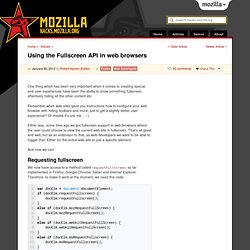
Remember when web sites gave you instructions how to configure your web browser with hiding toolbars and more, just to get a slightly better user experience? Or maybe it’s just me… :-) Either way, some time ago we got fullscreen support in web browsers where the user could choose to view the current web site in fullscreen.
That’s all good and well, but as an extension to that, as web developers we want to be able to trigger that. Either for the entire web site or just a specific element. And now we can! Requesting fullscreen We now have access to a method called requestFullScreen, so far implemented in Firefox, Google Chrome, Safari and Internet Explorer. Button Event Attribute. 2D Shadow Effects. Applying shadows using BlendmodeIn Part One we drew out some plain black shadows, but we want to use these shadow shapes for something more than drawing black areas on the screen.
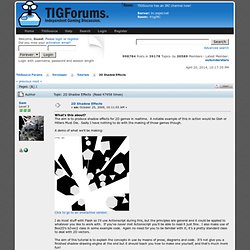
As everyone* knows, shadows aren't black but just darken whatever would normally be there. Flash can do this nice and speedily by using BlendModes. Box2D tutorials - Introduction - iforce2d. Last edited: April 07 2014 Chinese version -> 中文 Introduction Box2D is the world's most ubiquitous 2D physics engine.
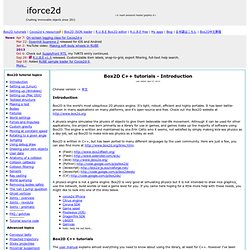
It's light, robust, efficient and highly portable. It has been battle-proven in many applications on many platforms, and it's open-source and free. Five ways to create objects… 1.

Simple Object Literal myApp.notepad = {}; myApp.notepad.writeable = true; myApp.notepad.font = 'helvetica'; myApp.notepad.setFont = function(theFont) { myApp.notepad.font = theFont; } Javascript Orienté Objet : syntaxe de base des classes JS à l’intention des développeurs PHP. Ce tuto a pour cible les développeurs qui ont une expérience du PHP (5) et qui veulent se lancer dans un projet Javascript qui dépasse le simple scripting.
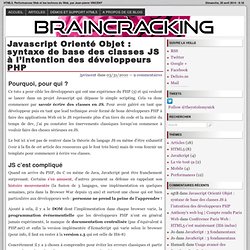
Cela va donc commencer par savoir écrire des classes en JS. Pour avoir galéré en tant que développeur puis en tant que lead technique avoir formé de bons développeurs PHP à faire des applications Web où le JS représente plus d’un tiers du code et la moitié du temps de dev, j’ai pu constater les énervements classiques lorsqu’on commence à vouloir faire des choses sérieuses en JS.
Le but ici n’est pas de rentrer dans la théorie du langage JS ou même d’être exhaustif (voir à la fin de cet article des ressources qui le font très bien) mais de vous fournir un template pour commencer à écrire vos classes. Quand on arrive du PHP, du C ou même de Java, JavaScript peut être franchement surprenant. Box2D, Web workers, Better performance. Sponsor: Register today for New Game, the conference for HTML5 game developers. Learn from Mozilla, Opera, Google, Spil, Bocoup, Mandreel, Subsonic, Gamesalad, EA, Zynga, and others at this intimate and technically rich conference. Join us for two days of content from developers building HTML5 games today. Nov 1-2, 2011 in San Francisco. Register now! WARNING: There is a bug with Chrome 15.0.874.5 dev (and probably earlier in the 15 dev channel series) that fires requestAnimationFrame twice per paint, which leads to very different results that you want. Box2dWeb Tutorials & Demos. WORLD CAMERA. Here we'll learn how to follow a Box2Dweb object with the camera.
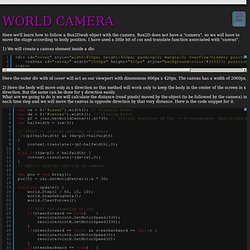
Programmation objet avancée : la conception avant tout (design patterns à l'emploi) Bonjour à tous, Voici un tutoriel qui a pour objectif d'aider les personnes à mieux cerner ce qui se cache derrière la programmation orientée objet.
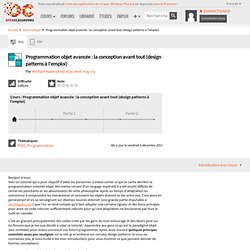
Moi-même venant d'un langage impératif, il a été plutôt difficile de cerner les penchants et les aboutissants de cette philosophie. Après un temps d'adaptation on commence à comprendre les mécanismes et comment les objets doivent se lier entre eux. C'est alors en persévérant et en se renseignant sur diverses sources internet (une grande partie imputable à developpez.com) que l'on se rend compte qu'il faut adopter une certaine rigueur et des bons principes pour avoir un code robuste, suffisamment robuste pour qu'une adaptation ne bouleverse pas tout le code en cascade. Box2D & JavaScript tutorials by Seth Ladd.
A suite of Javascript libraries and tools designed for working with HTML5. Recent Updates Follow @CreateJS November 2014 Added Unit Tests to EaselJSUpdates in preparation for new releases (coming soon).
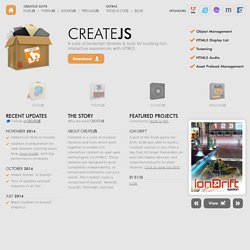
New class model, with big performance increases October 2014 Added 'Extras' to EaselJSTons of updates and pull requests in all libs July 2014 Major Updates to EaselJS Graphics.